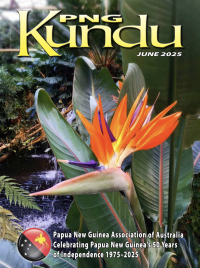Book Reviews: December 2008
Allied Air Transport Operations South West Pacific Area in World War II, Volume Three, 1943 – Air transport approaches full strength by Robert H Kelly
Kapiak Tree by Anna Chu
Bougainville Blue by Brian F Darcey
Allied Air Transport Operations South West Pacific Area in World War II, Volume Three, 1943 – Air transport approaches full strength, by Robert H Kelly
ISBN 978064648143 (hbk), 453 pp
Publisher Robert H Kelly 2008, $65 including postage
Available from author at PO Box 192, Buderim, Qld, 4556
Reviewed by John McAlpine
This is a handsomely produced and exhaustive account of the build up and vital operations of WW II air transport in the South West Pacific (SWP) area with an inevitable emphasis on New Guinea. Over 500 American C47s (DC3) and co-opted aircraft from Qantas, Australian National Airways, Guinea Airways and Ansett took part in these operations supported by trans Pacific operations with Liberators (B24) and C54 Skymasters (DC4). The volume details all individual aircraft operations, routes, loads, crews, awards, airstrip construction as well as personal reminiscences. It also details the involvement, strategic and tactical difficulties of the air supply, drop and support in the SWP including the Buna-Kokoda and the Markham paratroop battles. The volume has copious photos and maps and together with the previous two volumes covering the development of air transport 1903-1943 and 1943- the year of expansion and consolidation presents a magisterial coverage of the subject. A fourth volume covering 1944 is due to appear in 2009.
These volumes are a fascinating read, not only of military interest but of interest to any one who lived in the post-war DC3 era in TPNG to whom the relics of these air operations were part of the fabric of life.
Kapiak Tree, by Anna Chu
ISBN 9780980490312 (pbk) 122pp
Publisher MaskiMedia 2008, $24.50 plus p&p $3.50 within Australia (cheque or money order)
Available from PO Box 757, Ravenshoe, Qld 4888. Email publisher@maskimedia.com.au. Tel/Fax 07 4097 6940. www.maskimedia.com.au
Publisher’s note
Chu Leong set up business in Marienberg on the Sepik River in 1930. His eldest son was killed by American aircraft fire on the ill-fated internee-packed Dorish Maru in 1944. His daughters and other sons suffered Japanese occupation in a village on the Keram River. Anna ran her father’s trade store, mixed with officers on an idyllic colonial outpost and saw PNG Independence in Wewak in 1975. She survived the threats and gunfire of the Bougainville Revolutionary Army in 1989. Kapiak Tree provides a tasty melange of events on the Sepik River and elsewhere in PNG.
Bougainville Blue, by Brian F Darcey
ISBN 9780980481921 (pbk) 156pp
Publisher by Diane Andrews Publishing 2008, $29 incl postage within Australia
Available through www.bougainvilleblue.com or email dianepithie@gmail.com. More information is available on the author’s blog www.briandarcey.blogspot.com
Reviewed by Keith Jackson
Bougainville Blue, a novel by Brian F Darcey, is more than loosely constructed around events on Bougainville in the couple of decades from the late 1960s. A recent sojourn in Noosa relieved me of other responsibilities and gave me an opportunity to immerse myself in what turned out to be far more than a rattling good yarn. In fact, Brian subtitles his book ‘An Allegory’, which provides a neat insight into what the reader can expect.
The novel is articulated through a rich cast of nicely drawn characters, the principal of whom is Josip Nugui, a bright and well educated young Bougainvillean who is inexorably and somewhat reluctantly drawn into the struggle of his people against the development of the copper mine and the massive consequent disruption to the culture and lifestyle of the village people.
The plot is well conceived and nicely structured, with enough tension and twists to satisfy even the most jaded armchair adventurer. But the book is more than an absorbing novel. It is also a social and political commentary on attitudes of and towards Papua New Guineans around the time of national independence in the mid-seventies.
Beyond the politics of colonisation and change, it shows a depth of understanding about the nuances of PNG – the topography and ecology, the sights and smells, the eccentricities (e.g., the pretentiousness of ‘Kieta International Airport’), the contesting values and wilful behaviours of the main players – whether kiaps, Australian politicians, entrepreneurs, planters, the media or the native people themselves.
Wherever you go in this book, apart from the plot which is a fictional collage, although close enough to reality to be plausible, there is an authenticity of observation and an acute awareness of much of the tangible and latent stresses that characterised PNG at a time when many of us felt we knew the country very, very well.
Brian Darcey has written a splendid book and Diane Andrews has done us the service of editing and publishing it.




